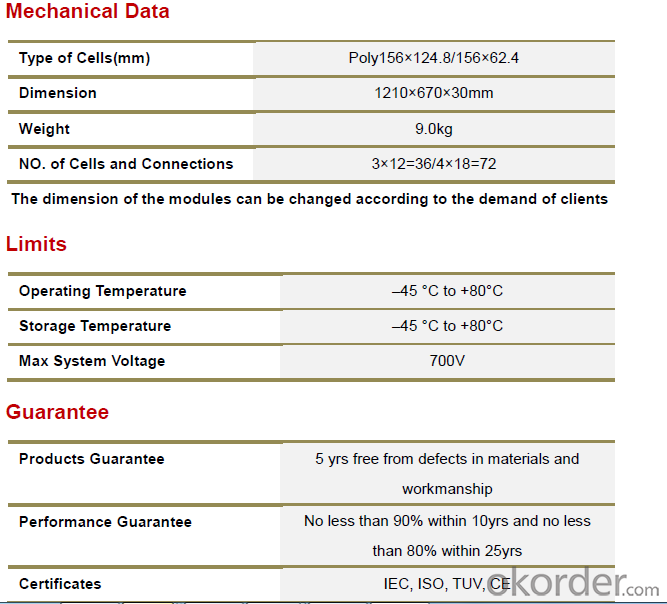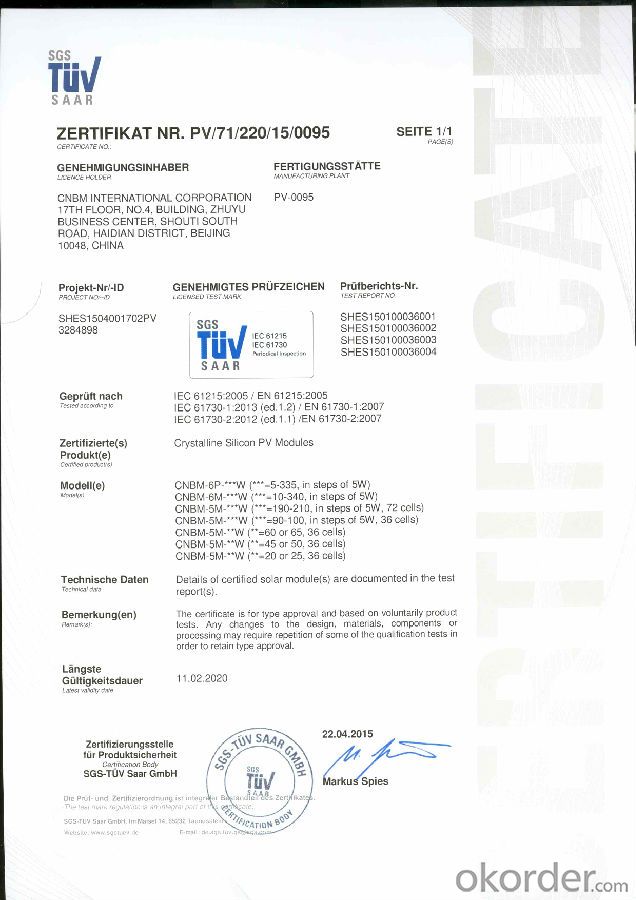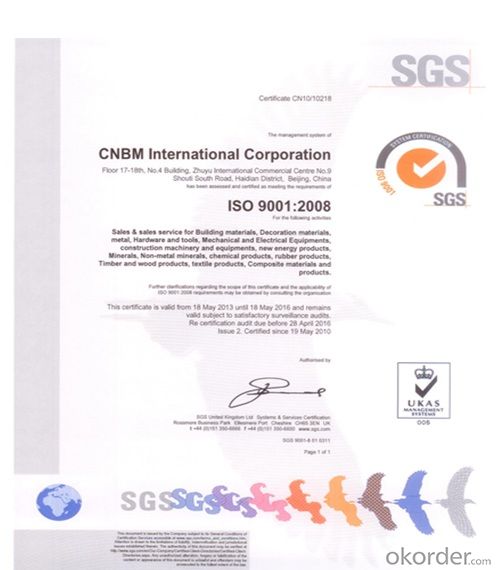Polycrystalline Solar Module-120w CNBM Series
- Loading Port:
- Shanghai
- Payment Terms:
- TT OR LC
- Min Order Qty:
- 25 pc
- Supply Capability:
- 30000 pc/month
OKorder Service Pledge
OKorder Financial Service
You Might Also Like
Polycrystalline Solar Module-120w CNBM Series
High efficiency crystalline solar cell. Even if under the weak light, the solar module can produce maximum power output.
II Tempered glass (toughened glass): Anti-reflecting coating and high transmission rate glass increase the power output and mechanical strength of solar module.
III EVA and TPT: Using high quality EVA and TPT to prevent destroying and water.
IV AI frame: Without screw, rner connection. 6 holes on the frame can be installed easily.
V Junction box: Multi function junction box with water proof.
VI Long lifetime: ≥25 years; Less power decrease.
VII Good performance of preventing from atrocious weather such as wind and hails.
VIII Resisting moisture and etching effectively, not effected by geology.
IX The certificate issued by international authority: UL, TUV, IEC, CE.
Standard Test Conditions of Polycrystalline Silicon Solar Panel
The opto-electrical specifications shown below are stabilized values being measured at Standard Test Conditions, Irradiance: 1000W/m2, Spectrum: AM1.5 at 25°C, The info below is subject to manufacturing tolerances. Where appropriate minutes of measurement are available and are used for the dimensioning of the installation.
Advantages of Monocrystalline Silicon Solar Panel
• CNBM Solar performance guarantees for 25 years
• 12 years guarantee for workmanship
• Timeliness of delivery
• Quality Products certified (TÜV, UL, CE, ISO)
Specification


Certification



FAQ
We have organized several common questions for our clients,may help you sincerely:
①What price for each watt?
It depends on the quantity, delivery date and payment terms,
②What is your size for each module? Can you tell me the Parameter of your module?
We have different series of panels in different output, both c-Si and a-Si. Please take the specification sheet for your reference.
③Can you provide the peripheral products of the solar panels, such as the battery, controller, and inverter? If so, can you tell me how do they match each other?
Yes, we can, we have two companies for solar region, one is CNBM International, the other is CNBM engineering Co.
We can provide you not only the solar module but also the off grid solar system, we can also provide you service with on grid plant.
④What is your warranty system?
Our product performance guarantees for 25 years
• 12 years guarantee for workmanship
• Timeliness of delivery
• Quality Products certified (TÜV, UL, CE, ISO)
⑤How do you pack your products?
We have rich experience on how to pack the panels to make sure the safety on shipment when it arrives at the destination.
⑥ Can you do OEM for us?
Yes, we can.
⑦How long can we receive the product after purchase?
In the purchase of product within three working days, We will arrange the factory delivery as soon as possible. The pecific time of receiving is related to the state and position of customers.Commonly 7 to 10 working days can be served.
- Q:How do solar panels affect roof aesthetics?
- Solar panels can have both positive and negative effects on roof aesthetics. On one hand, solar panels can enhance the look of a roof by providing a sleek and modern appearance, especially when integrated seamlessly into the roof design. On the other hand, some may argue that solar panels can detract from the overall aesthetic appeal of a roof, particularly if they are bulky or installed in a way that is visually obtrusive. However, with advances in solar panel technology, it is now possible to find more aesthetically pleasing options that blend well with different types of roofs, making them a viable option for homeowners concerned about both energy efficiency and the visual appeal of their roofs.
- Q:How do solar panels affect home resale value?
- Solar panels can positively impact home resale value by providing potential buyers with energy savings and a reduced carbon footprint. Studies have shown that homes equipped with solar panels tend to sell at a higher price compared to similar homes without them. Additionally, solar panels often increase a home's appeal and marketability, making it more attractive to environmentally-conscious buyers.
- Q:I have a 500 watt inverter and battery but need solar panels to run my need. I want to have enough juice to run a computer and monitor and sometimes a 5w amp. I am not sure how much power is needed to run the computer (standard desktop with 5flat screen with an additional surround sound system) though on the side of the computer it says 5 amp but I know I used to run it and monitor and surround sound with a heating blanket on the same circuit which was rated at 20 amps. My question is that I would like to go and buy some panels (cheaply as I'm unemployed) from somewhere like Harbor Freight that would meet the need of the converter to supply enough amperage. So what size panel(s) or panels would I need to run this setup? If I am correct I think 500 watts is equal to 5 amps. Would this even work? Could I run a partial system where I could run some of the stuff to take a load off? I need to lower my electric bill somehow. Thanks!
- Solar okorder in their survival discussion in the archive, this exact project was discussed at length.
- Q:What is the cost of installing solar panels?
- The cost of installing solar panels can vary depending on various factors such as the size of the installation, location, type of panels, and additional equipment needed. On average, a residential solar panel system can cost anywhere between $10,000 to $30,000 or more. However, it's important to note that there may be potential tax incentives, rebates, and financing options available, which can help offset the upfront costs and make solar panel installations more affordable.
- Q:Are there any fire risks associated with solar panels?
- Yes, there are some fire risks associated with solar panels, although they are relatively rare. The main causes of fire incidents include faulty installation, poor maintenance, electrical malfunctions, and extreme weather conditions. However, the risk can be significantly minimized through proper installation, regular inspections, adherence to safety codes, and using high-quality components. Additionally, advancements in technology and industry regulations continue to enhance the safety of solar panel systems.
- Q:Can solar panels be used in combination with other renewable energy sources?
- Yes, solar panels can be effectively used in combination with other renewable energy sources such as wind turbines, hydroelectric power, or geothermal energy. This combination, known as hybrid renewable energy systems, allows for increased reliability, better utilization of resources, and a more stable power supply.
- Q:Can solar panels be installed on public transportation systems?
- Yes, solar panels can be installed on public transportation systems. In fact, many cities around the world are increasingly integrating solar panels onto buses, trams, and trains to harness clean energy and reduce carbon emissions. These panels can be installed on the roofs or sides of vehicles, enabling them to generate electricity and contribute to the power needs of the transportation systems.
- Q:Can solar panels be used in disaster relief efforts?
- Yes, solar panels can be used in disaster relief efforts. Solar panels provide a reliable and sustainable source of electricity, which is crucial during times of disaster when traditional power grids may be disrupted. They can be used to power essential equipment, lighting, and communication systems in disaster-stricken areas, enabling emergency response efforts, medical services, and providing support to affected communities. Additionally, solar panels can be easily transported and set up in temporary shelters or mobile units, making them an efficient and versatile solution for disaster relief operations.
- Q:Hey was looking at a 5 watt 2 volt solar panel and was wondering if it'd be enough to power a regular light bulb. Also need to power a 5volt 6.5 amp pump for at most a minute at a time. So basically if I had this panel would I be able to plug a lamp into it and have it light for 5+ hours at a time with the possibility of running the pump? If not what size panel would I need?
- The specifications you give say the solar panel produces 5 watts at 2 volts (DC) so that isn't enough voltage to power an ordinary (20-volt) light bulb. You could get 0 of these panels and connect them in series so they put out a total of 20 volts and the total power available would be 50 watts. The panels would light the bulb that way, provided the bulb isn't over 50 watts and you can afford the panels. A panel does provide enough power for a 2-volt car light bulb less than 5 watts. However, the maximum current you can get from these panels is .25 amperes (5 watts divided by 2 volts = .25 A.) This isn't enough power to run your pump which takes 6.5 amperes - at 20 volts, that would be 780 watts. Another thing to check is the pump motor; many electric motors are designed to run on AC only and will be damaged if you try to run DC through them. Remember solar panels produce DC so the raw output from a panel will not work on an AC motor.
- Q:Can solar panels be used for charging laptops or smartphones?
- Yes, solar panels can be used for charging laptops or smartphones. Portable solar panels, such as those designed for outdoor activities or camping, are available in the market. These panels can convert sunlight into electricity and charge your devices through USB ports or power banks. Additionally, some laptops or smartphones also have the capability to directly charge from solar panels using special adapters or cables.
1. Manufacturer Overview |
|
|---|---|
| Location | |
| Year Established | |
| Annual Output Value | |
| Main Markets | |
| Company Certifications | |
2. Manufacturer Certificates |
|
|---|---|
| a) Certification Name | |
| Range | |
| Reference | |
| Validity Period | |
3. Manufacturer Capability |
|
|---|---|
| a)Trade Capacity | |
| Nearest Port | |
| Export Percentage | |
| No.of Employees in Trade Department | |
| Language Spoken: | |
| b)Factory Information | |
| Factory Size: | |
| No. of Production Lines | |
| Contract Manufacturing | |
| Product Price Range | |
Send your message to us
Polycrystalline Solar Module-120w CNBM Series
- Loading Port:
- Shanghai
- Payment Terms:
- TT OR LC
- Min Order Qty:
- 25 pc
- Supply Capability:
- 30000 pc/month
OKorder Service Pledge
OKorder Financial Service
Similar products
New products
Hot products
Related keywords



























